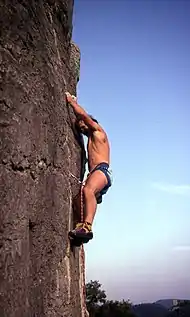Redpoint (climbing)
In sport climbing, redpointing means to free-climb a route while lead climbing, but after having practiced the route beforehand (either by hangdogging or top roping) to understand its technical challenges.[1] Many climbers will try to redpoint a route after having failed to on-sight (first time with no prior information), or flash (first time but with prior information) it, although a climber might forgo an onsight attempt if they suspect that the route is so difficult that it would be pointless to try.[1][2]
| Part of a series on |
| Climbing |
|---|
 |
| Background |
| Types |
| Lists |
| Terms |
| Gear |
Redpointing differs from the traditional climbing act of headpointing, in that the term is exclusive to sport climbing routes with protection bolts already pre-fixed into the rock at regular intervals.[2] Traditional climbing sometimes uses the derived term, "greenpointing" to describe leading a sport-type climb, but one that only uses pre-placed "natural protection" (e.g. the protection is not via fix preplaced protection such as bolts or iron pins).[3]
Where the quickdraws have been pre-placed into the bolts (i.e. the climber is just clipping in the rope on their lead), it is technically called a pinkpoint; in practice, most climbs on extreme sport routes are really pinkpoints, as are most climbs in modern climbing competitions, and the term "pinkpoint" is less frequently used.[2][4]
Climbers can rest on a redpoint, but not using the rope or any artificial protection (e.g. it must be by just handing off the holds, or using a kneebar).[2] Where the climber falls on a redpoint, they must stop the climb, return to the bottom, pull their rope free of the route, and completely re-start the attempt from scratch.[2]
The English term "redpoint" is a loan translation of the German Rotpunkt coined by Kurt Albert in the mid-1970s at Frankenjura. He would paint a red X on a fixed pin so that he could avoid using it for a foot- or handhold. Once he was able to free-climb the entire route, he would put a red dot at the base of the route. In many ways, this was the origin of the free climbing movement that led to the development of sport climbing ten years later.[2]
Notable redpoints
Notable redpointed climbs are chronicled by the climbing media to track progress in overall rock climbing standards and levels of technical difficulty; in contrast, the hardest traditional climbing routes tend to be of lower technical difficulty due to the additional burden of having to place protection during the course of the climb, and due to the lack of any possibility of using natural protection on the most extreme sport climbs.[5]
As of December 2021, the world's hardest redpointed route is Silence at a proposed grade of 9c (5.15d), which was climbed by Adam Ondra in 2017; it has yet to be repeated.[5] There are a number of routes with a confirmed climbing grade of 9b+ (5.15c), the first of which was Change by Ondra in 2012, and the second of which was La Dura Dura, also by Ondra and Chris Sharma in 2013.[5] As of December 2021, female climbers Angela Eiter, Laura Rogora, and Julia Chanourdie have redpointed established routes at 9b (5.15b), and Rogora's ascent of Erebor is considered to be the first potential female redpoint of a 9b/+ .[6]
References
- Berry, Adrian (2006). Sport Climbing + (1 ed.). Rockfax Ltd. ISBN 1-873341-86-5.
- "What Is A Redpoint In Climbing? – Climbing Jargon Explained". Climber. 2 October 2020. Retrieved 1 January 2022.
- "planetmountain.com". Retrieved October 16, 2012.
- Pesterfield, Heidi (2007). Traditional Lead Climbing: A Rock Climber's Guide to Taking the Sharp End of the Rope (2 ed.). Wilderness Press. ISBN 978-0-89997-442-2.
- Pohorsky, Matej (2018). "Climbing Milestones. Explore the Revolutionary Routes from 6a to 9c". eMontana (Czech). Retrieved 31 December 2021.
- "Laura Rogora: the 9b/+ Erebor exploit interview". PlanetMountain.com. 5 October 2021. Retrieved 1 January 2022.